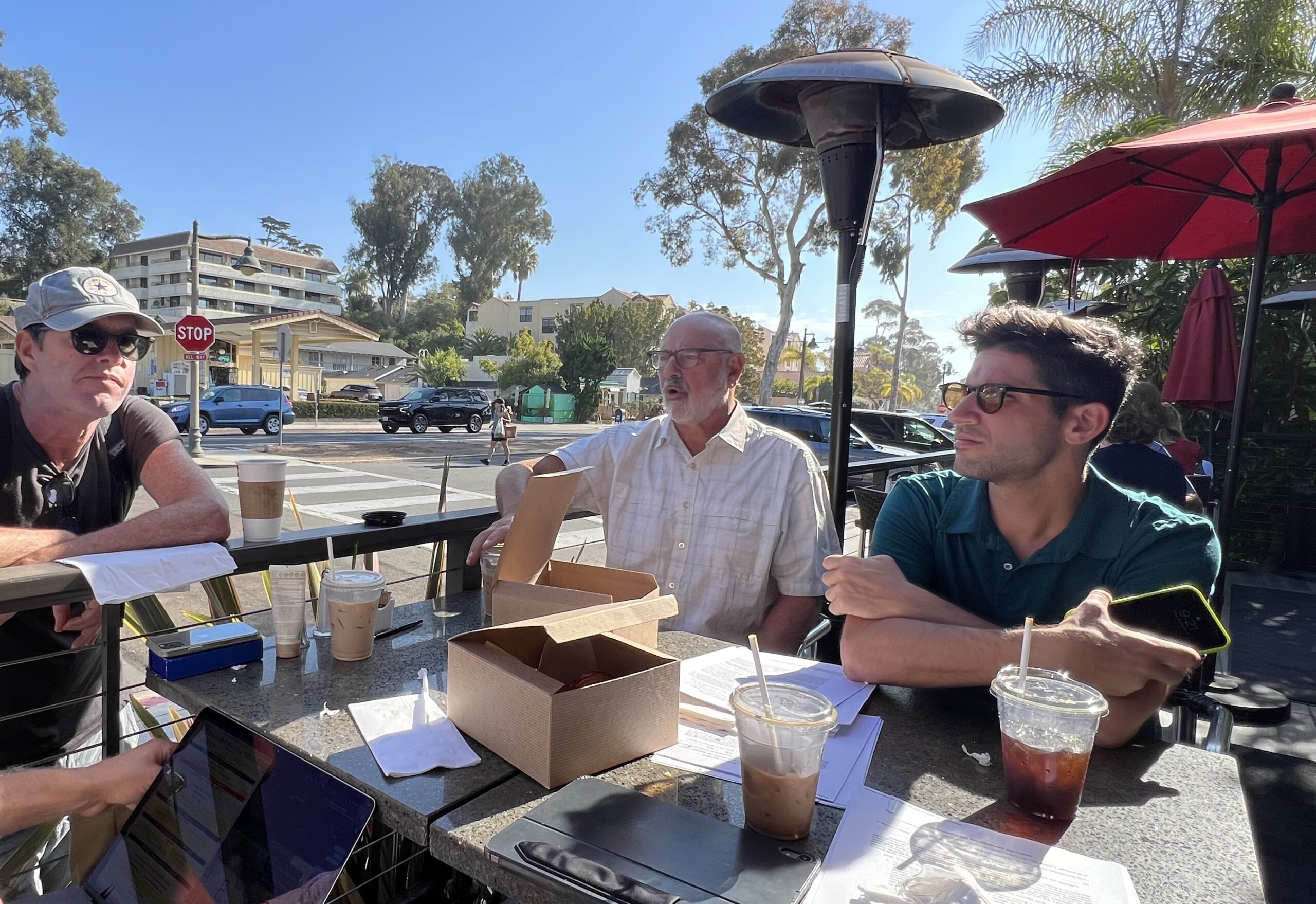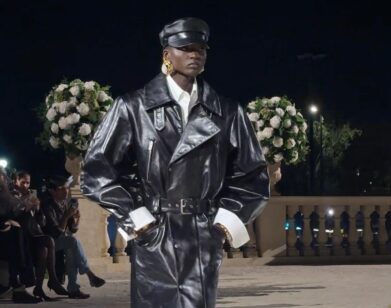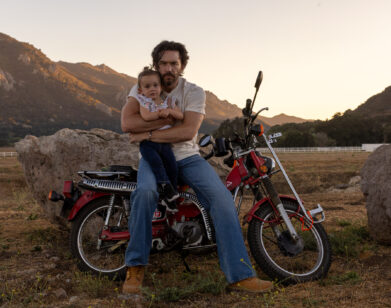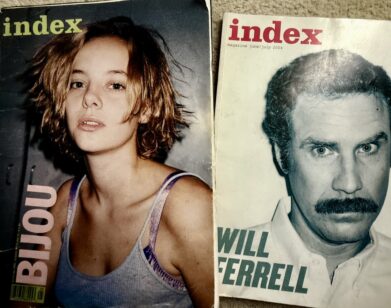BTS
On Location with Paul Eskenazi, the Man Behind the Sites of Succession

Director Mark Mylod (far left), Director of Photography Pat Capone (middle), and Location Manager Paul Eskenazi (right) scouting locations in Montecito for the first episode of season four.
$200 million dollar Hamptons estate, Nordic ski retreat, Croatian superyacht, and Montecito megamansion—the Roy dynasty’s environs are of course grotesquely unrelatable, but that’s just one of the great pleasures of Succession. When else but on a Sunday night can you board a private jet to immerse yourself in the quandaries of the .001%? As the hit HBO series nears its close, our editor-in-chief Mel Ottenberg tracked down the show’s location manager Paul Eskenazi for all the dirt on the filming locations that brought the drama to life over the past two seasons, from Logan’s Fifth Avenue townhome to the real-life ATN studio.—MEKALA RAJAGOPAL
———
MEL OTTENBERG: So Paul, your show is so cool. How did you get that job?
PAUL ESKENAZI: Oh man, good question, curveball. I interviewed for the show after season two completed and before season three started up. A friend of mine was the production manager on season two and it came up kind of nonchalantly in conversation that Succession is looking for a location manager. And I was like, “Yeah, please. I would love to throw my name into the mix.” Because it would be the first show I’ve worked on—if I got the job—that I watch. Which never really happens.
OTTENBERG: Got it.
ESKENAZI: I started officially on season three in January 2020. COVID lockdown shut us down for a few months, then we resumed production of season three in August 2020. Started shooting in the fall, and here I am. Season four, the only location manager to return to the show, which I will wear as a proud badge of honor. It’s a toughie for sure, but I love it.
OTTENBERG: What makes it so tough?
ESKENAZI: It is absolutely the expectation to deliver. This is really the only show that I’ve worked on where it’s like, nothing gets turned down. No matter how ludicrous the logistics are, or how pricey the fees can be, everyone’s just like, “All right Paul, can we do it?” And I’m like, “Oh, so we’re going to move forward. Okay, well then I guess I’ve got to deliver.”
OTTENBERG: Does that also work two ways? Because the show’s so hot that people are going to say yes to you?
ESKENAZI: I think I would equate working on the show in seasons three and four to what I imagine it was like when Sex and the City was shooting in New York, where it was a very of the moment, New York pop culture zeitgeist and everyone wanted to be a part of it. On one hand, there’s no shortage of restaurants, hotels, and stunning penthouse owners that reach out to me and want to be included. But there’s also no shortage of those exact same kinds of locations that our key creatives want that do not want us. And then they say, “Come on Paul, make it a yes. Turn that no into a yes.”
OTTENBERG: I’m sure that some of your job is an absolute nightmare of extreme proportions.
ESKENAZI: I would say all of it is an absolute nightmare. No, no…
OTTENBERG: Oh, just your job in general is a disaster. Disaster-laden career?
ESKENAZI: Sure. I mean, basically.
OTTENBERG: I mean, same.
ESKENAZI: Listen, I have to be honest, right? It’s pretty bad. At the same time, it’s incredible. The job is to be the intermediary between the giant egos in a production and in the real world. It’s like we’re the only department that gets it from every single direction. I’m not talking about Succession cause everyone’s lovely and wonderful. But it’s writers, producers, directors, talent—and then when we’re on a location, it’s the neighbors and the adjacent businesses that are mad that our lights are killing their business for the day. And then it’s the city. We’re taking too much parking and we’re messing up the traffic with our driving shot. So there are more roads to disaster for a location department than I think any other department on a show. But that being said, I’m a fixer, and it’s about being able to adapt and roll with it quickly and not skip a beat.
OTTENBERG: And everything is on location. What’s Logan’s house in reality?
ESKENAZI: The exterior and lobby are quite famously the Irish Historical Society on Fifth Avenue and 81st Street. In the pilot, they actually shot it on location. And then from that point forward, they built pieces of it on the stage. Other pieces of it are from the libraries at the Council on Foreign Relations, and the siblings’ residences are typically real residences, whether they’re on the market or inhabited. We’ve got a variety.
OTTENBERG: What about Shiv’s apartment. Was that whole pre-election party filmed on location?
ESKENAZI: It was multiple locations, actually. Those smaller ancillary rooms were offsite.
OTTENBERG: What was that rich, understated, minimal apartment?
ESKENAZI: It’s a new development on the Upper East Side, 180 East 88th Street. Kendall’s apartment was there as well, in episode four, earlier this season where he’s sitting down looking at that stunning view above some of the Upper East Side. That building lent itself quite well to these additional rooms that could be easily transformed, that didn’t have a lot of large oversized windows so we could make it nighttime without having to shoot overnight.
OTTENBERG: Since it’s all such high-level stuff, what’s the creative process? Are you out scouting in Norway?
ESKENAZI: There was an additional location team in Norway. I didn’t have any involvement in that. I was a part of Santa Barbara, the Nan Pierce Estate. Carolyn Schultz was our L.A. location manager. But before it was Norway, we were exploring a resort in Vancouver. I was working closely with the Vancouver location scout. Norway came about at a time when we were shooting and prepping the next episode. I have a team of three location scouts that work with me, Joel McGlumphy, Jonathan Knapp, and Paul Contos, who really, I mean, it’s them. I’m essentially the liaison between the directors and my scouts. I’ll share any clues that I get from them and we’ll brainstorm and spitball ideas.
OTTENBERG: Let’s back up for a second. How did you get into this career?
ESKENAZI: I always knew I wanted to be in “the biz,” so to speak. Since I was 10 years old, I’ve been obsessed with box office and TV ratings and music sales. I can tell you how much money any movie has ever made within $3 million dollars. I didn’t know what I wanted to do, but my second cousin gave me an internship and said if it works out, it’ll turn into an entry-level PA position, which it did. And then I kind of observed, and I saw that location managers in New York City, the really good ones, tend to go on to become production managers, who then go on to become line producers, and the really, really good ones become executive producers, creative producers. It was a department that I never even knew existed, but it was interesting to be kind of half creative and half logistics, because I think it truly is the only role that has to be both.
OTTENBERG: Since you’re on a production with so many different brilliant people, what’s next?
ESKENAZI: I want to produce, and I feel like in many ways, location managing is producing. On Succession in particular, there’s nothing like it. I’ve done them all, seen them all, every shape and size, and there truly has never been another show for me that is close to this. Especially in season four, when we didn’t know it was the final season until literally the last episode, but we all felt it coming, so there was an added layer of pressure. I would say the key detail for my role, especially this past season, is delivering the impossible. That’s the most fun part for me too, and the most rewarding by far, when it works out.
OTTENBERG: Where is ATN?
ESKENAZI: I don’t know if I can say.
OTTENBERG: Oh.
ESKENAZI: Oh, I’m allowed to tell you. ATN is CNBC.
OTTENBERG: Oh, wow.
ESKENAZI: Yeah. Which I think is recognizable because it’s their studio that appears on air. We were fortunate enough to work it out, HBO and CNBC. They’re wonderful inside and out, their team and crew who assisted us because we needed their real tech people to assist with filming in their studios. It was a big undertaking, weekends were the only time we could get in there. But an amazing, magnificent location.
OTTENBERG: And then boating, I don’t know anything about boats and I definitely wouldn’t have my wedding on one. But that’s the billionaire spot, right? It doesn’t look so great.
ESKENAZI: Well, the Hornblower is a fantastic boat and company, sincerely. It’s funny because when we were getting into that episode early on, the first thing I did, which is what I always do when we have a concept, Googling “Billionaire party boats and where are they?” And it’s not really a thing, and if it is a thing, it’s on a yacht. I think the key element of Connor’s narrative this season is his presidential candidacy and him wanting to appeal to the “everyday people” and the “real Americans of the country.” I think it was, more than anything, an attempt to have him be a little bit more relatable to the voters. They were supposed to go to Ellis Island, which was all tied into his presidential campaign.
OTTENBERG: Right. Where is the engagement part, the rehearsal dinner with all the Warhols?
ESKENAZI: It was The Grill.
OTTENBERG: That’s what I figured. I just haven’t been there in a long time. I was looking at it being like, “I bet it’s The Grill. I know my parents go there, it seems like somewhere my parents might go. Shit, I should go Uptown more often.”
ESKENAZI: The Grill is a hot lunch spot for power, Midtown finance people, etc. But the food’s excellent and the space is the former Four Seasons, so it’s classic and they were wonderful to work with.
OTTENBERG: So now that I’ve broken you down, what is a disaster that happened this season that you fixed? I don’t mean a drunken Logan Roy actor.
ESKENAZI: That’s all I’ve got for you. No, I’m kidding, there was none of that. I would say the biggest one was episode three with the boat. It was summer when we shot that episode and that is a really happening party boat that is booked every weekend for different events. I think we needed something like 13 total days, with enough time for our art department and grip and electric departments to light it and to dress it and to film. Fitting into their box of having Monday to Thursday this week and taking everything off and putting it back on was very, very challenging. But the Horn Blower team was instrumental in helping us find a way to keep the peace with everyone in Pier 40, where the boat docks from. We also did the arrivals tent on that episode at Pier 15, where you saw they had that gorgeous glass tent with the Americana Bluegrass Band that was singing before they all got on the boat. We had to construct that tent over two weeks. That was definitely a very challenging one. And in episode eight, you’ll see that was all ATN.
OTTENBERG: What are your real hours? Because I bet they’re psychotic.
ESKENAZI: The real hours are 24/7. That’s what they are.
OTTENBERG: 24/7. No, I get it. 24/7.
ESKENAZI: Fortunately I have a wonderful department and my team really handles set for the most part, so I don’t feel like I have to be in two places at once. But this season in particular, I loved being on set because it’s just the best place to be. So after we would scout, I’d always just end up there. 14, 16 hour days, and then when they’re in L.A. or Norway, you have to be on call at whatever time that works for them to do our Zooms and start planning ahead. But it’s not a chore. To feel like you’re involved with the creative process on this show is the best feeling.
OTTENBERG: What are you doing next? Because you’re out of a job.
ESKENAZI: Ooh, I’m out of a job. I don’t know. I am hopefully going to produce something great with my producing partner.
OTTENBERG: Yeah, hot.
ESKENAZI: Yeah, hot, right?
OTTENBERG: Yeah, it’s hot.
ESKENAZI: My producing partner is hot, too. She’s hot.
OTTENBERG: Oh, great. I love that.
ESKENAZI: It’s great, yep.
OTTENBERG: I’m excited to see the end. I’m ready. How many more episodes are there?
ESKENAZI: There’s three. Eight, Nine, Ten. You want to know the ending? I’ll tell you.
OTTENBERG: Yeah, yeah.
ESKENAZI: I’m kidding.
OTTENBERG: No, I actually really don’t want to know the ending.
ESKENAZI: Honestly, first and foremost, I’m a fan of the show. I watched it before I ever even would’ve dreamed about working on it. It was such a struggle because I’m like, “Man, I really don’t want to read these scripts because I want to be able to watch the show.” But I got to tell you, I really don’t know about [episode] 10. It was the final stretch, all the wheels had come off the wagon and I was just like, “Eh, I’m not going to read it. I think I can make it work.”
OTTENBERG: Wait, are you watching it every Sunday?
ESKENAZI: Of course. I look back at my time on the show in the production part of it, and it is brutal. It will push you to the edge of what you think your sanity can handle. But it’s so rewarding after to watch the episodes and see how it turns out. So I definitely watch every Sunday and I watch a little podcast after as well.
OTTENBERG: I love the podcast.
ESKENAZI: They’re good. I typically scan Reddit and Twitter for feedback on the new episode and everyone is hot about the fight on the balcony, which by the way was fantastic. Bob [Pulcini] and Shari [Springer Berman], our directors for that episode, did such a wonderful job, and obviously the writing was just stellar, and the acting, forget about it. The Tom and Shiv storyline is kind of the thread that is streamlining everything together this season. Their tragic love story is really the X-factor that is capturing the attention of more and different viewers than any previous season. And people are just like, “Where’s the baby? What are they doing? Does he know? Does she know? Are they going to say anything?”
OTTENBERG: I have two more questions for you. Is Shiv’s apartment for sale?
ESKENAZI: No comment.
OTTENBERG: Is Logan’s house for sale?
ESKENAZI: Well, it’s a set. Maybe you can buy the furniture. The plywood.
OTTENBERG: Wait, that’s an amazing sale though.
ESKENAZI: I’m kidding. I think it went to an auction company actually.
OTTENBERG: Well, congrats on the best work because it’s so fun to look at shows and be like, “Bad location, cheap, unrealistic.” I believed everything on the show. That’s why I wanted to talk to you, because I fucking believe it.
ESKENAZI: That reminded me that the other golden rule for me is to go to the real place every single time, even if it isn’t as visually impressive or interesting necessarily. I mean, look at Frank E. Campbell [Funeral Chapel]. That is the real deal. Obviously ATN is a fictional network, but we had to do it the right way, and you’ll see in the next three episodes, without revealing any spoilers or anything, we’re doing it all very real. A big joke that we all have is that the show is known for lots of handheld, tight, close up shots. So we’ll go to an epic location with scope and scale and we’ll be so tight on everyone, you don’t even see it. But that is part of why it works, because we’re not going to pander. Whether it’s all of it or a tiny little sliver where you could technically have done it anywhere, but we were not anywhere, we were in the place where it would really be.
OTTENBERG: Well, Paul. Thanks for talking to me.
ESKENAZI: You’re welcome. Thank you, Mel. I appreciate it.
OTTENBERG: That was fun.






